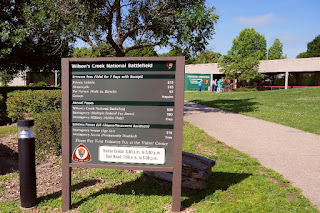Wilson's Creek National Battlefield in Southwest Missouri is worth a visit if you are in the area. The Visitor's Center includes an introductory film that runs near half an hour. The museum includes storyboards giving the historical context of this early battle, which was decisive for the slave-holding state of Missouri--and perhaps for the nation.
I recommend reading the information on the website to get an overview along with additional details regarding hours and fees.
The staff are helpful. And there are special events, which are listed on the webpage. Following the film, we viewed a musket firing demonstration. Notice the clothes of this man representing Col Franz Sigel's German troops. This was 10 August, 1861 before the Blue and Gray uniforms clarified which side a soldier represented.
Later, a volunteer told the story of the Ray family house, which became a field hospital during the battle. General Lyon, the first Union general killed in the war, was brought there before eventually heading back to his family in Connecticut. Read more on the John Ray family.
 |
| Ray House, Wilson's Creek Battlefield |
 |
| Gen Lyon brought to this bed |
The Ray House is also a story of slavery in the Ozarks. Here's a quote and link to more information about Rhoda Ray (Ray story)
Rhoda Ray was born a slave about 1824; she and her children were owned by John Ray. She was referred to as “Aunt Rhoda” by the Ray family, and she and the children worked on the Ray farm. During the Battle of Wilson’s Creek, on August 10, 1861, Rhoda and her children initially sought shelter in the cellar of the Ray house, then helped treat the wounded after the house was occupied as a Southern field hospital. Rhoda was freed in 1865 and moved to Springfield, Missouri, where she married John Jones in 1868; she “took in laundry” and her husband worked in a stone quarry. Rhoda Jones died in Springfield, Missouri, on November 4, 1897, and is buried in Hazelwood Cemetery.The tour road is accessed via a token-operated gate and is a one-way blacktopped road to the left. There are turnouts and parking areas along the route. Storyboards tell about local places and battle events. A phone number provides an audio message along the route.
In addition to the historical information, the site offers the beauty of the Ozarks -- green rolling hills in the spring and summer, various birds, white-tailed deer, wildflowers, and a variety of trees. And of course, there is Wilson's Creek. There are many well-marked trails as well.


Wilson's Creek itself is worth a few moments of tranquility and reflection.
 |
| White-tailed deer at Bloody Hill |
Rest rooms are available in the Visitor's Center.
And there is a picnic area nearby.

Connections































